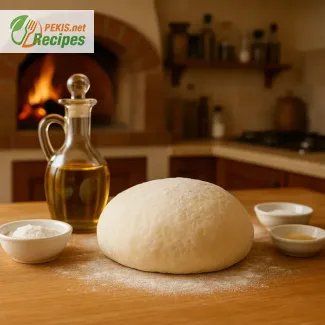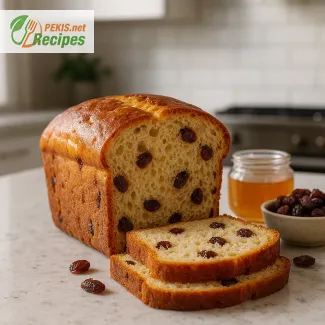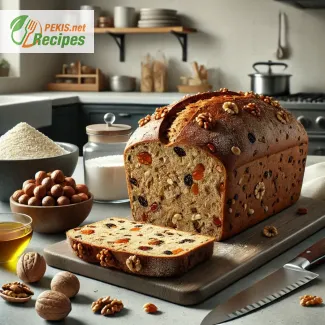Italian pizza dough makes 4 pizzas, with 20 minutes prep, 12 minutes baking, and a total of 32 minutes plus fermentation. Made with flour, water, yeast, olive oil, salt, and sugar, it creates a crust that is airy, crisp, and flavorful. Cold fermentation for up to 24 hours develops deeper taste and better texture. The dough keeps 2 days at room temperature, 4 days refrigerated, or 2 months frozen, making it versatile for weeknight cooking or special gatherings. The result is a light, elastic base perfect for authentic Italian-style pizzas baked in any oven.
PEKIS – professional chef and recipe developer with more than 25 years of experience, specialized in European and international cuisine. For this recipe, I bring in my background from working in traditional Italian kitchens, where mastering pizza dough was the foundation of every menu. My hands-on practice with flour, fermentation, and wood-fired ovens shaped the way I understand balance between crispy crust and airy softness, giving this recipe its authentic feel.

Mastering authentic Italian pizza dough at home
Traditional roots and cultural significance of Italian pizza dough
Italian pizza dough represents the essence of simplicity and craftsmanship in Mediterranean cuisine. Created from just a handful of basic ingredients, it transforms into a foundation that carries vibrant toppings, yet it holds its own distinct character. Centuries of tradition from regions such as Naples and Rome have shaped how flour, water, yeast, and olive oil are combined to create a dough that balances airiness, elasticity, and crispness. Neapolitan bakers perfected the method of long fermentation, which enhances flavor complexity and gives the crust a delicate chew, while Roman pizza traditions highlight thinner, crispier textures.
The origins trace back to humble street food prepared by local bakers who aimed to produce inexpensive yet filling meals for working-class families. Over time, Italian pizza dough evolved into a culinary symbol, closely linked to Italian identity and regional pride. Today it remains one of the most reproduced and celebrated preparations in kitchens across the world, admired for its versatility and ability to adapt to diverse toppings without losing authenticity.
Key characteristics of high-quality Italian pizza dough
- Elastic gluten network ensures the dough stretches without tearing, creating the thin base associated with Italian-style pizzas.
- Slow fermentation develops a mild tangy aroma, enhances digestibility, and contributes to the signature flavor of the crust.
- Olive oil adds richness, tenderness, and subtle fruity notes, supporting the balance between chew and crispness.
- High-protein flour provides structure and stability during baking, allowing the crust to hold its shape at high temperatures.
Why you will love this dough
- Reliable base for both thin-crust and traditional Neapolitan-style pizzas.
- Minimal ingredients with maximum flavor depth.
- Adaptable to wood-fired ovens, standard kitchen ovens, or even outdoor grills.
- Enhances the overall pizza experience with its light, airy texture and slightly crisp bite.
- Works well for both quick weeknight meals and slow weekend gatherings.
Storage and make-ahead instructions
Italian pizza dough can be prepared in advance to suit busy schedules without compromising quality:
- At room temperature: up to 2 days, covered to prevent drying.
- In the refrigerator: 3–4 days, which improves flavor development.
- In the freezer: up to 2 months, wrapped tightly to preserve moisture.
- For reheating pre-baked bases: 150 °C (300 °F) for 8–10 minutes until warm and crisp again.
Creative variations on Italian pizza dough
- Whole wheat version: adds nuttiness and extra fiber while retaining chewiness.
- Herb-infused dough: rosemary, oregano, or thyme kneaded directly into the dough for aromatic depth.
- Garlic oil enrichment: brushed on the dough before baking to enhance flavor.
- Sourdough base: replaces commercial yeast for a tangier, artisanal crust with natural leavening.
- Stuffed crust: cheese or seasoned oil sealed along the edges to elevate indulgence.
Practical tips for success
- Allow dough to rest adequately after kneading; this relaxes gluten and makes shaping easier.
- Use a baking stone or steel for intense bottom heat, imitating traditional wood-fired ovens.
- Hydration level influences texture: higher water content yields airier pockets, while slightly drier dough results in firmer crust.
- Handle dough gently during shaping to maintain air bubbles that create the signature airy texture.
Regional identity and culinary influence
Italian pizza dough is more than a simple recipe – it is a cultural artifact. Neapolitan pizza has been recognized by UNESCO as part of the world’s intangible cultural heritage, underscoring its importance beyond the kitchen. Whether enjoyed in a bustling pizzeria in Naples or recreated at home, the essence of authentic Italian pizza dough lies in respecting tradition while adapting techniques to modern kitchens.
- Dissolve yeast and sugar in lukewarm water, let it rest for 5–10 minutes until bubbles form.
- In a large bowl, combine flour and salt, then make a well in the center.
- Gradually pour in the yeast mixture and olive oil, mixing with your hand or a wooden spoon.
- Knead the dough for 10 minutes until smooth and elastic.
- Place the dough in a lightly oiled bowl, cover with a damp cloth, and let it rise at room temperature for 2 hours.
- Punch down the dough, then transfer to the refrigerator for cold fermentation (12–24 hours) to develop flavor.
- Divide into 4 equal pieces, shape each into a ball, cover, and let rest for another 30 minutes before rolling.
- Preheat the oven to 250 °C (480 °F) with a baking stone or steel inside.
- Stretch the dough gently by hand into circles, keeping edges slightly thicker for the crust.
- Top with desired ingredients and bake for 8–12 minutes until golden and crisp.
FAQ questionWhat is the best flour for Italian pizza dough?
The best choice is Tipo "00" flour, which has a high protein content and fine texture, making the dough elastic and easy to stretch while giving the crust its classic chew.
FAQ questionCan I use instant yeast instead of fresh yeast?
Yes, instant yeast works well. Simply adjust the amount: about 7 g (2 tsp) of dry yeast replaces 15 g (0.5 oz) of fresh yeast.
FAQ questionHow long should Italian pizza dough ferment?
For the best flavor and texture, allow a cold fermentation in the refrigerator for 12–24 hours. A shorter rise of 2–3 hours at room temperature also works but results in less complexity.
FAQ questionCan I freeze Italian pizza dough?
Absolutely. Divide the dough into portions, wrap tightly, and freeze for up to 2 months. Thaw overnight in the refrigerator before use.
FAQ questionWhy is my dough not stretching properly?
If the dough resists stretching, it likely needs more resting time. Allow it to relax for 15–20 minutes to let the gluten loosen before shaping.
FAQ questionHow do I get a crispy crust in a home oven?
Use a preheated baking stone or steel at 250 °C (480 °F). This mimics the high heat of traditional wood-fired ovens and ensures a crisp, golden base.
Italian pizza dough represents a balance of tradition and simplicity, showing how a few basic ingredients can turn into something remarkable. The mix of flour, water, yeast, olive oil, salt, and sugar creates a dough that carries authentic flavors while staying versatile for every kitchen. With careful fermentation, the result is a base that is light, airy, and crisp, making every pizza unforgettable.
The method is approachable yet refined, combining centuries-old Italian techniques with practical steps that anyone can follow. Allowing time for cold fermentation develops a depth of flavor, while proper kneading builds the essential structure of the dough. Each stage contributes to a crust that is both tender inside and beautifully crisp outside.
Flexibility is one of the greatest strengths of this dough. It adapts easily to both quick weeknight meals and longer, more traditional preparations. Whether baked in a wood-fired oven or a standard home oven, the outcome remains satisfying and true to its Italian roots.
Storing and reheating options make it even more useful. With the ability to last for days in the refrigerator or months in the freezer, Italian pizza dough becomes a reliable foundation for countless meals. This ensures that authentic pizza can be enjoyed whenever the moment calls for it, without compromise.
In every bite, the essence of Italy is present — a connection to culture, heritage, and culinary excellence. This dough is not only a recipe but a gateway to experiencing the timeless charm of Italian cuisine at home.
Allergens present in the recipe:
- Gluten (from wheat flour)
Suggestions to replace allergens and gluten:
- Replace all-purpose flour with gluten-free flour blend suitable for bread and pizza.
- Add xanthan gum (5 g / 1 tsp) to improve elasticity in gluten-free dough.
- For yeast intolerance, use sourdough starter instead of commercial yeast.
- Vitamin B1 (Thiamine): 0.35 mg – supports energy metabolism and nerve function
- Vitamin B2 (Riboflavin): 0.18 mg – contributes to healthy skin and vision
- Vitamin B3 (Niacin): 4.5 mg – important for digestive health and energy release
- Iron: 3.5 mg – essential for oxygen transport in the blood
- Magnesium: 28 mg – supports muscle and nerve function
- Zinc: 1.2 mg – important for immunity and wound healing
- Polyphenols from olive oil: 30 mg – help reduce oxidative stress and inflammation
- Vitamin E: 0.5 mg – protects cells from damage caused by free radicals





